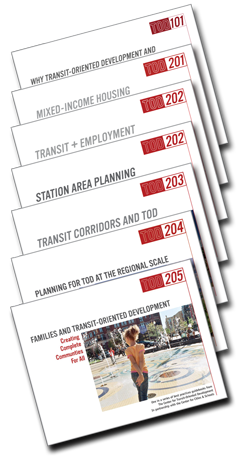| Year |
Document Name |
Partners/Publisher |
| 2013 |
Making It Happen: Opportunities and Strategies for Transit-Oriented Development
in the Knowledge Corridor |
CRCOG |
| This report provides a market analysis for potential transit-oriented development in the "Knowledge Corridor" between Hartford, Conn., and Springfield, Mass. Transit projects in the region include CTfastrak, a 9.4 mile bus rapid transit system; the NHHS rail service connecting Springfield to downtown Hartford; and restoration of the Vermonter Amtrak rail corridor, which connects Washington, DC, to St. Albans, Vermont. The TOD typology strategy contained in this report provides a framework for
understanding what transit-oriented investments might be, where they can leverage the greatest economic potential, and how they can be funded and implemented.The analysis identifies four basic station types – Outreach, Infill, Catalyze and Reposition. |
| 2013 |
Transit-Oriented Development Typology Strategy for Allegheny County |
GoBurgh |
| This Transit-Oriented Development Typology Strategy is designed to provide a framework for understanding where transit-oriented investments should be made, where they can leverage the greatest economic potential, and how they can be funded and implemented. Each station area in Allegheny County’s system has its own set of implementation needs to support transit-oriented development. The typology offers a framework for prioritizing and understanding these needs at a glance. There are additionally seven strategies that agencies and advocates can deploy to support and catalyze momentum for transit-oriented development across the entire transit system, regardless of place type. |
| 2011 |
Transit-Oriented Development Strategic Plan for Metro TOD Program |
Oregon Metro |
| CTOD developed the Strategic Plan in collaboration with Nelson\Nygaard Consulting Associates, Inc., and Metro TOD Program staff. The plan will ensure that the program maximizes the region's transit-oriented development opportunities and effectively leverages additional resources to advance TOD in station areas and frequent-bus corridors. The plan evaluates existing conditions around Portland, classifies station areas and corridors based on their readiness to support TOD, offers guidelines for phasing of TOD Program work and discusses future activities and funding strategies. |
| 2011 |
Connecting West Corridor Communities: An Implentation Strategy for TOD |
Various |
| The report was produced as part of a collaboration between the city and county of Denver, the city of Lakewood, the Denver Housing Authority and Metro West Housing Solutions. Known as the West Corridor Working Group (WCWG), the collaborators sought CTOD's expertise in creating a strategy for implementing successful transit-oriented development along the West Corridor light rail line operated by the Regional Transportation District (RTD) and scheduled to open in 2013. Project website. |
| 2011 |
Reinvesting in Pittsburgh's Neighborhoods: The Case for Transit-Oriented Development |
PCRG |
| This strategy report written for PCRG by CTOD staff identifies the potential that coordinated transit-oriented development initiatives have to enhance Pittsburgh's economic competitiveness; the value transit brings to the region; and the potential of leveraging both to make life more affordable and connect more people to jobs. The report also warns of the impact of transit's current funding crisis and calls for a realistic, actionable regional vision to advance transit and TOD. |
|
2010 |
Creating Successful Transit Oriented Districts in Los Angeles: A Citywide Toolkit for Achieving Regional Goals |
Caltrans, Metro |
| This report written with the support of Caltrans, assesses opportunities to improve land use and transportation linkages in communities surrounding 70 existing and planned transit stations in the City of Los Angeles. The report identifies strategies to help communities around transit stations achieve high transit ridership, increase mixed-income and mixed-use housing opportunities and create sustainable neighborhoods while offering its residents a wealth of travel options. Project website. |
|
| 2009 |
Central Maryland TOD Strategy: A Regional Action Plan for Transit-Centered Communities |
CMTA |
| In a year long process, the Center for TOD helped the Central Maryland Transportation Alliance identify priority locations for facilitating and generating momentum for market-driven TOD investments that can self sustaining over time. The report provides a methodology for planning and investment in any location, given the real estate development market and demographic data. |
|
| 2006 |
Denver TOD Typology and Strategic Plan |
City of Denver |
The Center for TOD helped the City of Denver created a Strategic Plan to guide planning prioritization and implementation activities of the City and County related to transit planning and transit-oriented development. City Council, Planning Board, departmental management, staff, and others have used it to; set priorities for where City resources should be directed in the short, mid and long-term; identified effective implementation tools, policies and strategies to facilitate transit oriented development where appropriate; and ensured close coordination among City departments, staff and others as they undertake planning and implementation activities related to transit and transit-oriented development.
|
|
| 2005 |
MTC TOD Policy |
MTC |
| The Center for TOD worked with the Metropolitan Transportation Commission in the Bay Area to develop a system for improving the cost effectiveness of regional transit expansion by setting development thresholds for certain transit types. The policy ensures that transportation agencies, local jurisdictions, members of the public and the private sector work together to create development patterns that are more supportive of transit. |
| 2005 |
BART TOD Real Estate Policy |
BART |
| The Center for TOD worked with BART in the Bay Area to develop a real estate policy that would strengthen the use of existing real assets while increasing transit ridership. |




